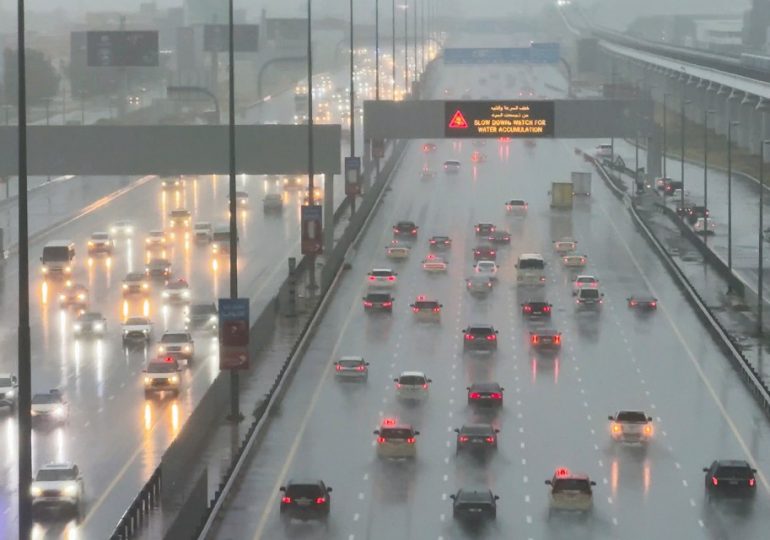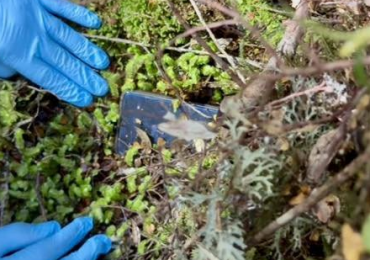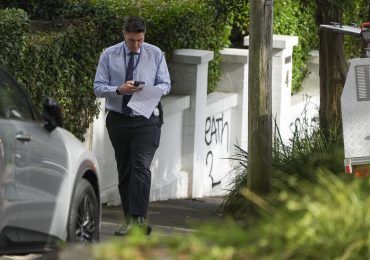DUBAI has been forced to deny the horrific floods paralysing the city have been self-inflicted through their infamous cloud seeding operations.
The glitzy city has come to a standstill as a years worth of rainfall fell in 24-hours leaving roads swamped underwater, schools and shops closed and airports plunged into carnage with one person dead.
APDubai has experienced a years worth of rainfall in just 24-hours[/caption]
GettyHeavy rainfall has battered Dubai as some have even claimed it could be self inflicted through cloud seeding[/caption]
EPADubai has said they haven’t done any cloud seeding since thunderstorms started on Monday evening[/caption]
Cars have been submerged by floodwater as Dubai struggles to drain away the masses of waterAP
The United Arab Emirates has relied on the cloud seeding phenomenon for decades.
It sees aircraft operators on the ground manipulating the weather to help with the dry, arid climate and make it a more liveable place.
Cloud seeding generally involves the government flying small planes through clouds which burn salt flares that can increase precipitation.
With the torrential, non-stop rain plaguing major cities like Dubai some are now claiming those in control of the weather have caused the almighty blunder themselves.
Flight-tracking data found by AP shows aircraft linked to the cloud seeding projects soaring above the iconic skyline on Sunday – hours before the rain started.
Ahmed Habib, a meteorologist at the UAE‘s National Centre for Meteorology (NCM) also claimed several specialist cloud-seeding jets were seen flying around in the days prior to the floods.
NCM has admitted seeding took place on Sunday and Monday, according to Bloomberg.
But they denied it happening on Tuesday when the heaviest downpours were felt.
Omar AlYazeedi, deputy director general of the NCM, said the agency “did not conduct any seeding operations during this event”.
He told CNBC: “One of the basic principles of cloud seeding is that you have to target clouds in its early stage before it rains, if you have a severe thunderstorm situation then it is too late to conduct any seeding operation.”
Seeding missions were first introduced to the UAE in the 1990s with over 1,000 hours of cloud seeding being done each year.
Dangers of cloud seeding
Cloud seeding has previously been labelled as dangerous by some scientists and medics over fears the silver iodide pellets that are dropped can be toxic to animals.
People also have concerns over what the artificial process could do to the earth’s natural balance of moisture and the effects it may have on evaporation and precipitation.
Despite the worries, nothing has been proven yet around the potential dangers.
Some feel this is due to the low amount of flights actually being done by the UAE alone.
Fears are expected to ramp up if it is done on a larger scale across the globe.
This helps to create 25 per cent more rainfall annually and drastically cool down the climate to make it more accessible for tourists and foreign residents.
Millions have reportedly been spent on the project since its inception.
More recently, China unveiled plans to control the weather and create artificial rain through a similar cloud seeding process.
They boasted the artificial rain will be able to cover more than 2million sqm – an area 22 times bigger than the UK.
RECORD BREAKING FLOODS
The torrential rain and flooding in Dubai in particular has submerged an airport, swamped malls and train stations and left Dubai paralysed.
It has been the heaviest rain ever recorded and wiped out the millionaire’s playground.
Planes were seen swimming in floodwater at the world’s busiest airport, Dubai International, as flights were diverted through yesterday afternoon and evening.
Dramatic pictures and videos showed shopping centres swamped and busy roads resembling rushing rivers dotted with halted cars.
People trudged through ankle-deep water in a metro station, and on roads as they attempted to push their flooded cars to higher ground.
It is a historic weather event, greater than any previously recorded in Dubai, where data collection began in 1949, according to state-run WAM news agency.
GettyDubai has been artificially creating rain for decades by shooting salt pellets into the clouds[/caption]
A group of men sail on a boat on a flooded street in Dubai
AFPTorrential rain swamped roads inf Dubai late Monday through to Tuesday[/caption]
Even recovery vehicles deployed in the floods have faced issues
Twenty-one outbound and 24 inbound flights were cancelled at Dubai International Airport (DXB) on Tuesday, while many other flights were diverted to neighbouring airports.
DXB was still affected on Wednesday morning, writing on X at 9am local time: “We advise you NOT to come to the airport, unless absolutely necessary.
“Flights continue to be delayed and diverted. Please check your flight status directly with your airline.
“We are working hard to recover operations as quickly as possible in very challenging conditions.”
By the end of Tuesday, 5.59 inches of rainfall had soaked Dubai in just 24 hours.
Schools across the UAE were largely shut yesterday and government employees, and other workers, urged to work remotely if able – both on Tuesday and again on Wednesday.
Tanker trucks worked in the streets and highways to pump away water, as flooding reached peoples homes and forced them outside.
What caused the heavy rain in Dubai?
A DELUGE of rain flooded Dubai on Tuesday, leaving at least one person dead and causing major disruption at the world’s busiest airfield.
The true cause of the heavy rain is not yet known, but some have theorised it may have been the result of cloud seeding.
Cloud-seeding is carried out in the UAE to increase the desert nation’s dwindling and limited groundwater supply, according to AP.
The weather modification technique involves small planes flying through clouds while burning special salt flares that can increase precipitation.
Meteorologists at the National Centre for Meteorology said they flew six or seven cloud-seeding flights before the rains commenced, according to reports.
And flight-tracking data analysed by the AP reportedly showed that one aircraft affiliated with the UAE’s cloud-seeding efforts flew around the country on Sunday.
A lack of drainage on roads and in other areas of the UAE – due to the irregularity of rain – is believed to have worsened the flooding.
XDubai International Airport has been swamped with rainfall on the runways[/caption]
People have been seen pushing their cars to higher ground as they wade through water up to their waistsAFP
ReutersPassengers wait for their flights at the Dubai International Airport on Wednesday[/caption]
EPACars are forced to a standstill on flooded roads[/caption]
Travellers wade through ankle-deep water in a flooded metro station
The glitzy city of Dubai has come to a standstill thanks to the flooding that has caused total carnageReuters
Leave a comment








